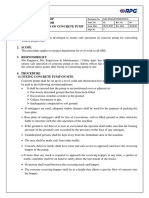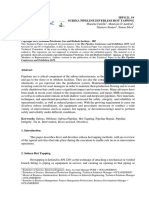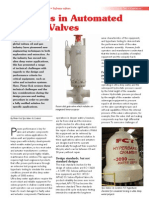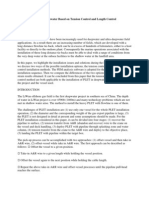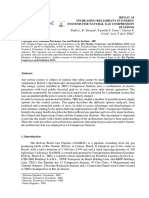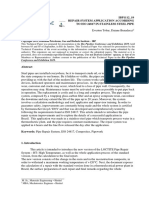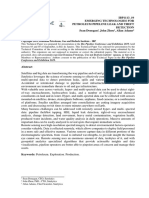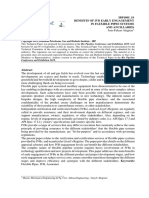Ibp1236 12
Ibp1236 12
Uploaded by
Marcelo Varejão CasarinCopyright:
Available Formats
Ibp1236 12
Ibp1236 12
Uploaded by
Marcelo Varejão CasarinOriginal Title
Copyright
Available Formats
Share this document
Did you find this document useful?
Is this content inappropriate?
Copyright:
Available Formats
Ibp1236 12
Ibp1236 12
Uploaded by
Marcelo Varejão CasarinCopyright:
Available Formats
IBP1236_12 INNOVATIVE SUBSEA PIPELINE MAINTENANCE IN LINE WITH EMERGING OFFSHORE TRENDS AND MAINTENANCE SAFETY STANDARDS George
Lim1
Copyright 2012, Brazilian Petroleum, Gas and Biofuels Institute - IBP
This Technical Paper was prepared for presentation at the Rio Oil & Gas Expo and Conference 2012, held between September, 17-20, 2012, in Rio de Janeiro. This Technical Paper was selected for presentation by the Technical Committee of the event according to the information contained in the final paper submitted by the author(s). The organizers are not supposed to translate or correct the submitted papers. The material as it is presented, does not necessarily represent Brazilian Petroleum, Gas and Biofuels Institutes opinion, or that of its Members or Representatives. Authors consent to the publication of this Technical Paper in the Rio Oil & Gas Expo and Conference 2012 Proceedings.
Abstract
Subsea hot tapping of pipelines is performed for a variety of reasons, including tie-ins, pipeline repair, insertion of instrumentation, facilitating chemical injection or providing access for temporary isolation tools. The full hot tap process that is, installing the hot tap assembly, performing the tap and recovering the hot tap machine is normally conducted with diver assistance. After bolting the assembly of the machine, isolation valve and fitting to the pipeline (or machine and isolation valve to a pre-installed flanged membrane on the pipeline), the divers then operate the machine to perform the tap, under instructions from and supervision by hot tap technicians located on deck of the diving support vessel (DSV). Subsequent unbolting and removal of the hot tap machine is also carried out by the divers. The demands of deep water have necessitated development of a totally diver-less, remotecontrolled system. Diver operations are limited to a maximum of 300 meters of water depth, whereas a significant portion of existing subsea field infrastructure, as well as projected future developments, are in deeper waters in depths up to 3,000 meters. In addition, diver safety concerns in shallow water, as well as impaired diver efficiency in difficult environmental conditions such as wave breaking zones, prompts the call for a reduction of diver exposure or complete elimination of diver assistance. The recent completion of a remote-controlled hot tap machine (the Subsea 1200RC Tapping Machine) is a first step toward developing a totally diver-less system. The installation of the hot tap assembly and subsequent removal of the machine still require diver assistance, but the performance of the tap itself is remotely controlled by a hot tap technician from the deck of the DSV. The concept is a topsidedriven hot tap machine with passive Remote Operating Vehicle (ROV) interface, which means a stationary ROV with its hydraulics and control system attached to the Subsea 1200RC machine and operated from an on-board laptop. This results in a lightweight hot tap frame and total direct control of the cutting process. The machine has been designed, built, tested and successfully deployed on a recent subsea tap for a pipeline operator in Asia. This technology promotes the separation of man and machine proposition. It reduces risk by reducing diver exposure, enhances safety, provides direct control and visibility from a laptop and facilitates fast and accurate execution. Ultimately, the concept may be extended toward onshore hot tap applications in risky environments calling for remotely operated systems. The purpose of this paper is to demonstrate a major new contribution in terms of knowledge and expertise to the offshore pipeline maintenance environment. It will detail the process and procedures, as well as delve into a customer application and the results. Part of the details will include areas of testing of the equipment, conditions in which it is designed to perform and how the needs of the pipeline operators were incorporated into the execution of the project. The results of the operation are meant to demonstrate how technology is progressing in line with emerging offshore trends, especially offshore exploration in Brazil.
1. Introduction
The hot tapping of subsea pipelines is nothing new; subsea taps have been successfully performed for decades, and for a variety of reasons, including maintenance, to facilitate line isolation activities or chemical injection, or to tie-in new lines to existing networks. Traditionally, subsea taps have been performed by divers working under the guidance of trained tapping personnel who direct diver activities from aboard a topside diving
______________________________ 1 Regional Manager, Offshore Business Development - T.D. Williamson, Inc.
Rio Oil & Gas Expo and Conference 2012 support vessel (DSV). With minor variances, subsea tapping typically follows a very predictable progression, as follows: 1. Pipeline cleaning and gauging. Having deployed from the DSV, divers descend to the pipeline and identify the precise location for hot tapping work. Once the line is uncovered sufficiently, a high pressure water blaster or other device is used to remove the lines tough protective coating. Grinders are then employed to take the line down to bare metal for a distance of four pipe diameters on each side of the chosen tap location. It is also imperative that the tapping fitting be (at minimum) one pipe diameter away from any girth weld. Additionally, any longitudinal weld seam must be (at minimum) 90 degrees from the center of the tap bore. In order to verify that that pipe is sufficiently straight and suited for tapping, divers check the ovality of the prepared area using a Pipe Ovality Go / No Go Gauge. Divers then check that the gap with pipe curvature at each clock along the axis is within allowable gap size using a level / straight edge. Divers use ultrasonic (UT) technology to check the complete circumference of the pipe every two inches between the seals and where the collets of the fitting clamp will engage the pipe. 2. Assembly and lowering. The tapping machine, temporary or permanent isolation valve and hot tap clamp / fitting are assembled and tested on the deck of the topside work vessel. Once testing is complete, rigging is attached and the entire assembly is lowered to the seabed and aligned for diver use. 3. Installation. Divers position the hot tap clamp on the pipeline and actuate the clamps rams to close the clamp. Studs are tightened, and pressure tests are performed on the annulus between the pipe and the fitting. If all goes well, the isolation valve can be opened. 4. Tapping. A hydraulic power unit lowered to the seabed near the work area supplies power for tapping. In most cases, subsea taps in shallow waters are performed in a horizontal mode at the 3 and 9 oclock positions to ensure a flat, sideways tie-in connection. This is preferable to a vertical tap at the 12 oclock position, which results in an upwardly protruding tie-in connection that necessitates use of protective structures over the tie-in works. Divers then carry out a predictable sequence of operations. First, they slowly advance the cutter until the tip of the pilot drill contacts the pipe. Then the drive motor is engaged, and the cutter is advanced until the pilot drill actually penetrates the pipe. The cutter advances until the tap is completed and the coupon (cut out section of the pipe) is retained on the end of the pilot drill. At this point the clutch on the tapping machine is disengaged, and the cutter and the coupon are fully retracted into the tapping machine adapter. 5. Equipment recovery. Once hot tapping is finished, divers close the isolation valve, then conduct verification and purging activities. They detach the hot tap machine from the isolation valve and verify that the coupon is on the pilot drill as expected. The tapping machine can then be lifted back to the surface and the coupon retrieved. 6. Connection. If preparing for a tie-in, the spur line can then be connected to the permanent hot tap valve. Once the valve is opened, the connection can begin service. As described above, each stage of subsea tapping involves varying degrees of diver participation. And, since traditional tapping machines have historically not included built-in sensors (other than local pressure gauges), the visual observations of the divers are the best (and in some instances only) way to know what is going on inside the line during the tap. This places a tremendous responsibility on the divers. It is important to remember that these divers are not typically experienced hot tap technicians. Rather, they are professional divers working on behalf of the installation contractor. These divers receive onshore hot tap training before subsea operations commence, and during operations they follow directions relayed to them via intercom by a tapping expert aboard the DSV. But even under the best tutelage, these divers are still not professional hot tap technicians. To further complicate matters, the ongoing quest for oil and gas reserves is pushing pipelines into deeper and deeper waters, which poses real challenges for divers. Divers cannot operate in depths greater than 300 meters, yet extraction operations are increasingly taking place in depths down to 3,000 meters. The needs of new ventures in deep waters are increasing the demand for diver-less, remote-controlled hot tapping systems. Once developed, such a system would have additional applications outside deep water, as in shallow water conditions where diver safety or effectiveness is impaired by difficult environmental conditions, such as wave breaking zones.
Rio Oil & Gas Expo and Conference 2012
2. System Overview
T.D. Williamson (TDW) has performed more than 300 diver-assisted subsea hot taps during the past three decades. The experiences gained during these operations were instrumental in the development of a new remotecontrolled hot tap machine called the Subsea 1200RC Tapping Machine. As shown in Figure 1, this machine represents a major step toward the eventual evolution of a completely diver-less system.
Figure 1. The new Subsea 1200RC Tapping Machine allows hot tapping to be carried out via remote control onboard a diving support vessel.
To develop a completely diver-less tapping system, consideration first turned to the most critical step: the hot tap itself. TDW engineers had several criteria for their work, including the need for direct control and operational visibility from a remote laptop. It was also important to use conventional installation methods and marine spreads, and to economically and efficiently develop a workable approach. Building on existing technologies would be key. The Subsea 1200RC Tapping Machine is based on the Subsea 1000 Tapping Machine, which has a proven track record. TDW engineers took the Subsea 1000 Tapping Machine and built a remote-controlled system around it, effectively creating a topside-driven hot tap machine with passive remotely operated vehicle (ROV) interface. As shown in Figure 2, this means that the tapping machine is self-contained, with a built-in hydraulic and control system. This system is powered by a stationary ROV and controlled using a laptop by a technician aboard a DSV. The Subsea 1200RC Tapping Machine is not currently a completely diver-less system. Diver assistance is still required for fitting installation, hot tap assembly installation and subsequent removal of the machine. However, since the tapping itself is controlled remotely, the machine does represent a departure from the traditional approach to subsea tapping, in which all parts of the process require divers. Thus, it is a significant step toward a diver-less system and an advance in the separation of man and machine ideal. Risk is reduced and safety is enhanced by decreasing diver exposure. Further, the machine offers both direct control and high visibility via the laptop interface, which facilitates rapid and precise execution. However, the system is completely diver-less if pre-installed 3
Rio Oil & Gas Expo and Conference 2012 tees are present on the pipeline, in which case the Subsea 1200RC Tapping Machine with isolation valve attached can be readily deployed and connected to the tee with a mechanical quick connector.
Figure 2. Because the new system allows the tapping operation to be controlled by a technician, it is a better method of hot tapping than the industry standard practice, which involves using ROV arms to carry out a range of valve functions.
One of the primary breakthroughs with the Subsea 1200RC Tapping Machine is that it does not require the development of specialized support systems. Standard Work Class ROVs can supply the hydraulic and electronic power needs. Alternatively, subsea power units with similar properties can be used as needed. The ROV supplies hydraulic power (in a closed loop) to engage a motor / pump unit on the frame of the tapping machine. This motor / pump unit then sends hydraulics to the appropriate motor / hydraulic functions. As stated previously, operations are fully monitored and controlled on the surface by expert technical personnel. A control program was devised to operate the diver-less hot tapping system from a laptop. This program includes the ability to run the feed and drive motors, as well as engage / disengage the clutch. All critical parameters (including pressure, temperature, cutter position and proximity, rotation speed and movement of the boring bar and cutter) are relayed from tapping machine sensors to the display on the laptop. Also, a range of generic contingencies are programmed into the machine to prepare for system failures of the hydraulics, electronics or machine parts. These contingencies include duplicate monitoring systems and overrides by ROV mechanical interfaces. In this way, diver participation is not required for the most critical aspects of the hot tapping process. Diver assistance is still needed during other stages of the tapping process pipeline cleaning and gauging, assembly and lowering, installation, equipment recovery and connection. The ultimate goal, however, is for the whole tapping process to be remotely performed. 4
Rio Oil & Gas Expo and Conference 2012
3. System Features
The Subsea 1200RC Tapping Machine is driven by two hydraulic motors the feed motor and the drive motor. Each motor has separate functions, and they are never used in tandem. The feed motor is used to rapidly extend the cutter from the home position to just above the pipe before tapping starts. Once the tap is complete, the feed motor also retrieves the cutter to the home position. There is no cutter rotation during these operations. Once the cutter is in position, the drive motor drives its rotation. The gearbox of the tapping machine includes a clutch. With this clutch disengaged, the feed motor extends or retracts the cutter. With the clutch engaged, the gearbox advances the cutter at a fixed rate relative to cutter rotation. In conventional hot tapping procedures, divers manually operate the clutch. In the Subsea 1200RC Tapping Machine, a hydraulic cylinder installed on the tapping machine and operated from the DSV laptop allows the clutch to be engaged and disengaged by remote control. A position sensor reads the position of the clutch and transmits this data to the laptop. Divers are occasionally required to turn the feed motor one-quarter turn in order to engage it; this need has been addressed by the system software, which automatically runs the feed motor slowly until the engage position is reached. The Subsea 1200RC Tapping Machine is pressure-balanced for seawater depth and pipeline pressure. Two separate accumulator systems enable this pressure balancing. A one-gallon bladder equalizes gear case lubricant to sea water pressure. A 15-gallon bladder pressure-compensates the boring bar to pipeline pressure. In some instances it is better to compensate the boring bar to seawater pressure through use of a valve arrangement. For most subsea tapping operations, an adapter is used to join the tapping machines lower flange to the isolation valve. The outer end of the adapter typically has a flange compatible with the size and style of the valve. In some instances, the adapter may incorporate or be bolted to one end of a Mechanical Quick Connector (MQC), with the other end fitted to the valve. This is standard practice in a completely diver-less system. The tapping adapter is generally at ambient (sea) pressure when tapping starts, but the adapter pressure instantly adjusts to pipeline pressure at the moment the pilot drill goes into the pipe. At the same time, the 15-gallon accumulator simultaneously pressurizes the tapping machine frame (and everything inside it) to pipeline pressure. The only exception to this is the gear case, which stays equalized to ambient (sea) pressure. As a result of the pressure compensation, the risk of a leak should the boring bar seal fail is greatly diminished because the pressure load on the bar is essentially negated. Should the pipeline pressure be less than the ambient (sea) pressure, the tapping machine will be equalized to sea pressure rather than pipeline pressure; this minimizes the thrust load on bearings. As shown in Figure 3, an ROV (or similar power unit) supplies the primary hydraulic power and electronic power for the Subsea 1200RC Tapping Machine. The ROV connects to the tapping machine through the ROV panel, with one stab for hydraulics and one for electric. As a contingency, the ROV panel includes manometers (pressure gauges) to facilitate visual monitoring (through ROV cameras) of line pressure, tapping machine pressure and main hydraulics pressure for the valve pack. The ROVs hydraulic stab provides hydraulic power for the tapping machine. The ROVs electrical stab provides electrical power, plus communication and video signals to and from the tapping machine. A tapping technician aboard the DSV operates the tapping machine through the umbilical and this connector. Both the communication to the valve pack and the video feed from the cameras pass through the stab connector.
Rio Oil & Gas Expo and Conference 2012
Figure 3. Using its own hydraulic power unit, the ROV stabs into the tapping machine control panel and holds on to the grabber bar during tapping. The Subsea 1200RC Tapping Machine includes its own hydraulic system. This system is operated through application of primary hydraulic power from the ROV to a motor pump unit. The technician on the DSV uses the laptop control to communicate with the valve pack on the hydraulic system through the electrical ROV connector, selecting which function to run or stop. The valve pack includes three valves (plus one spare), and these control the hydraulic functions on the tapping machine. As shown in Figure 4, the diver-less tapping machine is operated through a specially designed control program loaded onto a laptop computer. This program controls all tapping machine functions, including engaging the clutch as well as running the feed and drive motors. The tapping machine can be operated either manually or automatically, and the control program allows for easy navigation between various steps of the automatic mode and manual mode. The automatic mode operates according to values set in an electronic measuring card similar to the paper versions used normally. If a stall occurs, the control program senses this and automatically switches to manual mode, which then allows the operator to retract the boring bar and resume cutting in automatic mode.
Figure 4. A software control program was developed to manually or automatically operate all tapping machine functions from a laptop computer. 6
Rio Oil & Gas Expo and Conference 2012 The control system includes pressure sensors that relay information to the main window of the control program. Some critical pressures also have a manometer that can be watched via the ROV camera at the ROV panel. These monitor motor and drill pressures as well as the supply and return hydraulic line pressures. A tachometer position sensor counts revolutions of the tapping machine. Rotation can also be observed visually through the cameras. The rotation wheel has magnets; the signals from these magnets are picked up by an encoder. Rotation is converted to movement (distance) of the boring bar, with both rotation speed and movement observable on the laptop window. The position of the boring bar can be reset and monitored during retraction using a reset proximity sensor. When this sensor makes contact with the magnet, retraction automatically slows down and stops when fully retracted. Standard hot tapping machines typically feature a rigid measuring rod, but this long stick protrudes upward and can pose a snagging danger from umbilical cables when used in a subsea setting. The Subsea 1200RC Tapping machine utilizes a flexible measuring rod, which consists of a rubber hose with markings, reeled on a standard drum and spring loaded. This hose is attached to a swivel joint fixed onto the tapping machines retainer shaft. When the boring bar is expanded, the hose follows, allowing visual measurement of the bars movement through the camera. The Subsea 1200RC Tapping Machine features two cameras. The first camera captures the boring bars rotation and position, while the second camera captures the clutch cylinders position. Each camera serves to back up the other. Both can be moved to varying positions to increase visibility. The standard ROV only has one line available to send visual signals; a valve pack switch box makes it possible to switch between cameras. ROVs also include cameras of their own. The Subsea 1200RC Tapping Machines working envelope is defined by that of the Subsea 1000 Tapping Machine, which was designed for diver operations. Therefore, the system is constrained by inherent limitations posed by the Subsea 1000 Tapping Machine. This will be addressed in future designs. Currently, the positive differential pressure is limited to 153 bar (2220 psi), a limit arising from inherent design, mechanical resistance and flange limits. On the other end of the spectrum, negative differential pressure is limited to -106 bar (-1542 psi), a limit arising from the maximum negative loads on the bearings. In applications where line pressure is below ambient (sea) pressure, the pressure balance accumulator should be connected to sea pressure. Close attention was paid to the need for contingencies and remedial measures during the development of the Subsea 1200RC Tapping Machine. In accordance with offshore standards, a risk analysis was completed, and the findings were incorporated in the design. In addition, any part failure has been anticipated and appropriate contingencies developed. Should the need arise, an ROV torque tool receptacle allows for mechanical override of the system. One receptacle overrides the feed motor, and one overrides the drive motor. Both were designed in accordance with ISO 13628-8:2002 (ROV Interfaces on subsea production systems). In the unlikely event of total breakdown of the remote-control system, the ROV can still operate the boring bar, allowing for either job completion or retrieval of the machine, leaving the pipeline in a safe, controlled condition for subsequent re-entry and remedial action.
4. Field Use
The new Subsea 1200RC Tapping Machine has already proven itself in the field. As seen in Figure 5, it was first tested and successfully deployed in 2011 during a hot tap operation for a customer in the Java Sea in Asia. Before the hot tap operation, a series of tests including an integrated mock-up of the hot tap onshore took place at the TDW facility (as well as the customers offshore base) in Singapore. During these tests, the Subsea 1200RC Tapping Machine performed as planned. After the integrated system made up of the Subsea 1200RC Tapping Machine, clamp, and isolation valve was tested and approved, the operation commenced offshore. A 16-inch tap was performed on an existing 28-inch gas pipeline at a water depth of 91 meters (298 feet). TDW personnel performed the operation from a dive support vessel, and the cutting operation lasted about two hours. The entire operation was conducted safely, even as flow through the gas pipeline remained uninterrupted. The tie-in connection point was ready when the line was later tied in. Rather than requiring an expensive new pipeline running hundreds of miles to an onshore receiving station, gas can now be exported from the Kangean field to the existing gas export line at a fraction of the cost, saving valuable time and money. 7
Rio Oil & Gas Expo and Conference 2012
Figure 5. The Subsea 1200RC Tapping Machine and clamp assembly as it is lowered into the sea during a successful operation in Asia.
5. Conclusions
As evidenced by the Java Sea project, the Subsea 1200RC Tapping Machine system has proven that it is feasible to conduct the critical hot tapping operation entirely by remote control, significantly reducing dependence upon divers and thus increasing safety. Other benefits also result, most notably the enhanced control now possible. The Subsea 1200RC Tapping Machine offers total control and visibility of the tapping operation where none previously existed. Built-in sensors enable continuous monitoring of pressures and temperatures, as well as the rotation and movement of the pilot drill and cutter. Thanks to built-in sensors, cameras and monitors, topside technicians can see precisely what is going on inside the enclosed space at the heart of the cutting operation. The laptop-based control program gives technicians complete remote control over the tapping process, rather than relying on divers manual handling. This ensures accuracy and greatly improves the quality of the execution. If development of a completely diver-less hot tap system one addressing all stages of the hot tap operation, including pipeline cleaning and gauging, installation, valve manipulations, connect and disconnect functions, as well as the tapping itself is the ultimate goal, the experience already gained with this remotecontrolled tapping machine will prove invaluable. This advance is not limited to the offshore arena. Looking forward, the significant benefits afforded by a remote-controlled tapping system are likely to have a tremendous impact on both offshore and onshore hot tap operations. Since the Subsea 1200RC Tapping Machine promotes the separation of man and machine concept, its advantages should be widely relevant. A remotely operated system improves the overall safety of hot tapping operations, which should be particularly useful in emergency situations calling for pipeline intervention and repair in dangerous environments.
You might also like
- Sop For Set Up & Operation of Concrete PumpDocument3 pagesSop For Set Up & Operation of Concrete Pumplelu ojhaNo ratings yet
- Bulk Material Handling: Practical Guidance for Mechanical EngineersFrom EverandBulk Material Handling: Practical Guidance for Mechanical EngineersRating: 5 out of 5 stars5/5 (1)
- Wrights Offshore Hydrate Remediation Skid ArticleDocument4 pagesWrights Offshore Hydrate Remediation Skid ArticleAnonymous ItzBhUGoiNo ratings yet
- Oil and Gas Artificial Fluid Lifting TechniquesFrom EverandOil and Gas Artificial Fluid Lifting TechniquesRating: 5 out of 5 stars5/5 (1)
- Method Statement DPE GL1 Cooling Water Line CleaningDocument15 pagesMethod Statement DPE GL1 Cooling Water Line CleaningDheeraj Chowdary DhanekulaNo ratings yet
- Standard Operating ProceduresDocument5 pagesStandard Operating ProceduresDominic Kibet-TooNo ratings yet
- Terrain Drainage Design Dubai MunicipalityDocument16 pagesTerrain Drainage Design Dubai MunicipalityChamara Chinthaka Ranasinghe100% (2)
- SPE 00039328 AutotrackDocument8 pagesSPE 00039328 AutotrackdiegoilNo ratings yet
- Subsea Well Intervention TechnologyDocument25 pagesSubsea Well Intervention TechnologyYohanest Chandra100% (3)
- Coiled Tubing Operations at a Glance: What Do You Know About Coiled Tubing Operations!From EverandCoiled Tubing Operations at a Glance: What Do You Know About Coiled Tubing Operations!Rating: 5 out of 5 stars5/5 (2)
- Riopipeline2019 1121 201906051235ibp1121 19 Final PDFDocument8 pagesRiopipeline2019 1121 201906051235ibp1121 19 Final PDFMarcelo Varejão CasarinNo ratings yet
- Pipeline InstallationsDocument13 pagesPipeline InstallationsOni Ayo100% (3)
- Advances in Automated Subsea ValvesDocument3 pagesAdvances in Automated Subsea ValvesSyko GuyNo ratings yet
- Seawater TreatDocument22 pagesSeawater TreatEvêncio ChipiNo ratings yet
- Future Requirements For Deep Water Remote Intervention Proposal For A Remotely Operated Repair StationDocument12 pagesFuture Requirements For Deep Water Remote Intervention Proposal For A Remotely Operated Repair StationAmit ShuklaNo ratings yet
- Drilling Procedures OMC ABDocument25 pagesDrilling Procedures OMC ABJesse EsparzaNo ratings yet
- SPE 94377 Abandonment of Seabed Deposition of Drill Cuttings During Offshore DrillingDocument4 pagesSPE 94377 Abandonment of Seabed Deposition of Drill Cuttings During Offshore Drillingmsmsoft90No ratings yet
- Mechanical PlugsDocument6 pagesMechanical Plugskategord50% (2)
- 8 6 8Document6 pages8 6 8sonerNo ratings yet
- IBP1064 - 19 Where Offshore Meets Onshore: Trenchless Solutions For Pipeline LandfallsDocument10 pagesIBP1064 - 19 Where Offshore Meets Onshore: Trenchless Solutions For Pipeline LandfallsMarcelo Varejão CasarinNo ratings yet
- Managed Pressure Drilling (SPE MPD Seminar Abstracts)Document6 pagesManaged Pressure Drilling (SPE MPD Seminar Abstracts)Anonymous H9n5g3aaCENo ratings yet
- Drilling Procedures OMC ABDocument25 pagesDrilling Procedures OMC ABKiril BurdinNo ratings yet
- Chapter-11 Off-Shore DrillingDocument22 pagesChapter-11 Off-Shore Drillingzimbazimba75No ratings yet
- In Line Sled (Ils)Document6 pagesIn Line Sled (Ils)xonepotNo ratings yet
- Completation Inteligent RevistaDocument9 pagesCompletation Inteligent RevistaGabriel Castellon HinojosaNo ratings yet
- Installation / Operation / Maintenance Instructions Magnetic Level GaugeDocument6 pagesInstallation / Operation / Maintenance Instructions Magnetic Level GaugeHumayun NawazNo ratings yet
- Pigging in Pipeline Pre-Commissioning PDFDocument8 pagesPigging in Pipeline Pre-Commissioning PDFhemn100% (2)
- Workover - 10Document34 pagesWorkover - 10chemkumar16No ratings yet
- PLET Installation in Deepwater Based On Tension Control and Length ControlDocument13 pagesPLET Installation in Deepwater Based On Tension Control and Length Controlatish_g4100% (1)
- Deck SealDocument7 pagesDeck SealAlamin Siddique100% (1)
- Pipeline Tow MethodDocument25 pagesPipeline Tow Methodctrlaltdestroy100% (1)
- HW 1 SolutionDocument5 pagesHW 1 SolutionNisargPatelNo ratings yet
- SAOGE 2008 - Paper - Full Scale Verification of The Reelwell Drilling MethodDocument10 pagesSAOGE 2008 - Paper - Full Scale Verification of The Reelwell Drilling MethodBep De JongNo ratings yet
- Flood Testing Procedures: Shower Pans and Horizontal ApplicationsDocument4 pagesFlood Testing Procedures: Shower Pans and Horizontal ApplicationsKrishnasamy SanjeevanNo ratings yet
- 13 PiggingDocument14 pages13 PiggingDaniel DamboNo ratings yet
- 2005 Aberdeen 2 RussellDocument8 pages2005 Aberdeen 2 RussellLiner MasterNo ratings yet
- Operation LNG TankDocument4 pagesOperation LNG TankpramodtryNo ratings yet
- Cut The Cost and Raise The Reliability of Your InstrumentationDocument5 pagesCut The Cost and Raise The Reliability of Your InstrumentationJulie MerrillNo ratings yet
- TDS169Document5 pagesTDS169Noz KiNo ratings yet
- OTC 15191 Case History of A 5 Zone Multi-Drop Hydraulic Control Intelligent Offshore Completion in BruneiDocument7 pagesOTC 15191 Case History of A 5 Zone Multi-Drop Hydraulic Control Intelligent Offshore Completion in BruneihuongvieteventNo ratings yet
- High Pressure CleaningDocument8 pagesHigh Pressure Cleaningmc chester100% (2)
- Underground Piping and Services SystemsDocument29 pagesUnderground Piping and Services SystemsNabil Al-Khirdaji50% (2)
- Deck Machinery Maintenance Phase IIDocument31 pagesDeck Machinery Maintenance Phase IISahil SinghNo ratings yet
- Gas Inerte Semi SecoDocument6 pagesGas Inerte Semi SecoGaston GonzaloNo ratings yet
- New Enhancements To Pressure Control Systems Used in Wireline Service Operations G.R. Gibling G.Z. Fehrmann G.R. DavisDocument15 pagesNew Enhancements To Pressure Control Systems Used in Wireline Service Operations G.R. Gibling G.Z. Fehrmann G.R. DavisRoii RoyyNo ratings yet
- Pigging in Pipeline Pre-Commissioning PDFDocument8 pagesPigging in Pipeline Pre-Commissioning PDFAbhiyan Anala Arvind100% (1)
- Flood Testing Procedures: Shower Pans and Horizontal ApplicationsDocument4 pagesFlood Testing Procedures: Shower Pans and Horizontal ApplicationsKasturi LetchumananNo ratings yet
- Preparing A Prover For A Water Draw CalibationsDocument3 pagesPreparing A Prover For A Water Draw CalibationsLeonel NavaNo ratings yet
- Ongc &: Oil Well Production TestingDocument35 pagesOngc &: Oil Well Production TestingDayanand Singh100% (1)
- Heightened Regulations Create Demand For Well Abandonment ServicesDocument2 pagesHeightened Regulations Create Demand For Well Abandonment ServicesAdrien OfthestoneNo ratings yet
- Well Control Equipment Maintenance Inspection Cour 240429 190610Document53 pagesWell Control Equipment Maintenance Inspection Cour 240429 190610hayam.aarefNo ratings yet
- Pipework Maintenance: 15.1 Maintenance-Key To Trouble-Free ServiceDocument6 pagesPipework Maintenance: 15.1 Maintenance-Key To Trouble-Free ServiceAde Sari TrianaNo ratings yet
- HF Treatment Through DSTDocument8 pagesHF Treatment Through DSTmoorpvrNo ratings yet
- Sewage Disposal Works: Their Design and ConstructionFrom EverandSewage Disposal Works: Their Design and ConstructionNo ratings yet
- Estimator's Piping Man-hours Tool: Estimating Man-hours for Carbon Steel Process Piping Projects. Manual of Man-hours, ExamplesFrom EverandEstimator's Piping Man-hours Tool: Estimating Man-hours for Carbon Steel Process Piping Projects. Manual of Man-hours, ExamplesNo ratings yet
- Site Safety Handbook for the Petroleum IndustryFrom EverandSite Safety Handbook for the Petroleum IndustryRating: 5 out of 5 stars5/5 (1)
- Riopipeline2019 1138 Rio Paper Rev01 PDFDocument11 pagesRiopipeline2019 1138 Rio Paper Rev01 PDFMarcelo Varejão CasarinNo ratings yet
- IBP1146 - 19 Maintenance Productivity Measurement Study at TranspetroDocument8 pagesIBP1146 - 19 Maintenance Productivity Measurement Study at TranspetroMarcelo Varejão CasarinNo ratings yet
- IBP1141 - 19 The Use of Optical Sensor To Investigate Dissolved Oxygen in CrudeDocument12 pagesIBP1141 - 19 The Use of Optical Sensor To Investigate Dissolved Oxygen in CrudeMarcelo Varejão CasarinNo ratings yet
- IBP1142 - 19 Offshore Development: Submarine Pipelines-Soil InteractionDocument13 pagesIBP1142 - 19 Offshore Development: Submarine Pipelines-Soil InteractionMarcelo Varejão CasarinNo ratings yet
- Riopipeline2019 1140 Ibp 1140 Nao Intrusivos Final PDFDocument4 pagesRiopipeline2019 1140 Ibp 1140 Nao Intrusivos Final PDFMarcelo Varejão CasarinNo ratings yet
- Riopipeline2019 1127 Article Number Ibp1127 19 PDFDocument10 pagesRiopipeline2019 1127 Article Number Ibp1127 19 PDFMarcelo Varejão CasarinNo ratings yet
- Riopipeline2019 1135 Riopipeline2019 t1135 JST Av1Document8 pagesRiopipeline2019 1135 Riopipeline2019 t1135 JST Av1Marcelo Varejão CasarinNo ratings yet
- Riopipeline2019 1137 201906031307ibp1137 19 Increas PDFDocument10 pagesRiopipeline2019 1137 201906031307ibp1137 19 Increas PDFMarcelo Varejão CasarinNo ratings yet
- Riopipeline2019 1126 Article Number Ibp1126 19 PDFDocument11 pagesRiopipeline2019 1126 Article Number Ibp1126 19 PDFMarcelo Varejão CasarinNo ratings yet
- IBP1128 - 19 In-Service Welding Hot Tap of Refinary Pipeline With Hydrogen and EthyleneDocument10 pagesIBP1128 - 19 In-Service Welding Hot Tap of Refinary Pipeline With Hydrogen and EthyleneMarcelo Varejão CasarinNo ratings yet
- IBP1123 - 19 Caliper Ili Experience in Offshore Pre-CommissioningDocument10 pagesIBP1123 - 19 Caliper Ili Experience in Offshore Pre-CommissioningMarcelo Varejão CasarinNo ratings yet
- Riopipeline2019 1124 Worlds First Remote Deepwater PDFDocument10 pagesRiopipeline2019 1124 Worlds First Remote Deepwater PDFMarcelo Varejão CasarinNo ratings yet
- Riopipeline2019 1120 Ibp1120 19 Transpetro S Worklo PDFDocument9 pagesRiopipeline2019 1120 Ibp1120 19 Transpetro S Worklo PDFMarcelo Varejão CasarinNo ratings yet
- IBP1122 - 19 High Grade Sawl Linepipe Manufacturing and Field Weld Simulation For Harsh EnvironmentsDocument11 pagesIBP1122 - 19 High Grade Sawl Linepipe Manufacturing and Field Weld Simulation For Harsh EnvironmentsMarcelo Varejão CasarinNo ratings yet
- Riopipeline2019 1117 Ibp1117 19 Versao Final para e PDFDocument8 pagesRiopipeline2019 1117 Ibp1117 19 Versao Final para e PDFMarcelo Varejão CasarinNo ratings yet
- Riopipeline2019 1112 FM 1112 FinalDocument10 pagesRiopipeline2019 1112 FM 1112 FinalMarcelo Varejão CasarinNo ratings yet
- IBP1110 - 19 The Relevance of Fuel Transmission Pipelines in BrazilDocument10 pagesIBP1110 - 19 The Relevance of Fuel Transmission Pipelines in BrazilMarcelo Varejão CasarinNo ratings yet
- IBP1119 - 19 Internal Corrosion Detection: Conference and Exhibition 2019Document4 pagesIBP1119 - 19 Internal Corrosion Detection: Conference and Exhibition 2019Marcelo Varejão CasarinNo ratings yet
- IBP1111 - 19 Best Alternative For Rigid Offshore Pipelines Decommissioning - A Case StudyDocument13 pagesIBP1111 - 19 Best Alternative For Rigid Offshore Pipelines Decommissioning - A Case StudyMarcelo Varejão CasarinNo ratings yet
- Riopipeline2019 1113 201906031824ibp Riopipeline 11 PDFDocument10 pagesRiopipeline2019 1113 201906031824ibp Riopipeline 11 PDFMarcelo Varejão CasarinNo ratings yet
- Riopipeline2019 1107 201905201751ibp1107 19 Jacques PDFDocument7 pagesRiopipeline2019 1107 201905201751ibp1107 19 Jacques PDFMarcelo Varejão CasarinNo ratings yet
- IBP1101 - 19 Element Simulations and Offshore ObservationsDocument13 pagesIBP1101 - 19 Element Simulations and Offshore ObservationsMarcelo Varejão CasarinNo ratings yet
- Riopipeline2019 1090 201906111002ibp1090 19 The Rol PDFDocument9 pagesRiopipeline2019 1090 201906111002ibp1090 19 The Rol PDFMarcelo Varejão CasarinNo ratings yet
- Riopipeline2019 1104 201906031512fm 3811 00 Formato PDFDocument11 pagesRiopipeline2019 1104 201906031512fm 3811 00 Formato PDFMarcelo Varejão CasarinNo ratings yet
- IBP1099 - 19 Deep Water Pip Installation Using Reel-Lay MethodDocument12 pagesIBP1099 - 19 Deep Water Pip Installation Using Reel-Lay MethodMarcelo Varejão CasarinNo ratings yet
- IBP 1102 - 19 A Gas Routing Identification System On A Pipeline NetworkDocument12 pagesIBP 1102 - 19 A Gas Routing Identification System On A Pipeline NetworkMarcelo Varejão CasarinNo ratings yet
- IBP1095 - 19 in Flexible Pipes Systems and AncillariesDocument8 pagesIBP1095 - 19 in Flexible Pipes Systems and AncillariesMarcelo Varejão CasarinNo ratings yet
- Riopipeline2019 1093 201905221205final Paper Overpi PDFDocument12 pagesRiopipeline2019 1093 201905221205final Paper Overpi PDFMarcelo Varejão Casarin100% (1)
- Veneration Without Understanding by Renato ConstantinoDocument2 pagesVeneration Without Understanding by Renato ConstantinoCARLOS NORIEL CABANANo ratings yet
- Emerging and Reemerging Infectious DiseasesDocument13 pagesEmerging and Reemerging Infectious DiseasesSayu100% (1)
- Sales Contract FinalDocument4 pagesSales Contract Finalvothinhatlinh2k3No ratings yet
- Freight Terminals: CharacteristicsDocument6 pagesFreight Terminals: Characteristicskim jeonNo ratings yet
- Ripper Tip D11Document2 pagesRipper Tip D11Max SashikhinNo ratings yet
- Targeted Patient Safety QuestionnairesDocument27 pagesTargeted Patient Safety QuestionnairesAafreen KhairNo ratings yet
- PL SQL Student Guide v-3Document96 pagesPL SQL Student Guide v-3Ethical RAhul SinghNo ratings yet
- Noorul Hadith 007 - May & June 2019Document64 pagesNoorul Hadith 007 - May & June 2019Mohammad Omar FaruqNo ratings yet
- Communication Networking by Anurag Kumar PDFDocument2 pagesCommunication Networking by Anurag Kumar PDFSilvia0% (4)
- B.E. CSE FinalDocument124 pagesB.E. CSE FinalbalaNo ratings yet
- Identify The Industry Case Solution and Analysis, HBR Case Study Solution & Analysis of Harvard Case StudiesDocument2 pagesIdentify The Industry Case Solution and Analysis, HBR Case Study Solution & Analysis of Harvard Case StudiesCanvas KathaNo ratings yet
- BrightCast Business PlanDocument46 pagesBrightCast Business PlanMA. CHRISTINA BUSAINGNo ratings yet
- Vision Statement & Plan For Incorporating Leadership, Advocacy, & Professional DevelopmentDocument2 pagesVision Statement & Plan For Incorporating Leadership, Advocacy, & Professional Developmentapi-387300365No ratings yet
- Integrated Network Manager: Specification SheetDocument1 pageIntegrated Network Manager: Specification SheetRamonNo ratings yet
- Els-003 LH Options Guide FinalDocument31 pagesEls-003 LH Options Guide FinaltilahunbejigoNo ratings yet
- Village Hotel ClubDocument2 pagesVillage Hotel ClubAnastasia CristianaNo ratings yet
- M C Mon G: MC Mong - WikipediaDocument3 pagesM C Mon G: MC Mong - Wikipediagigi mulutNo ratings yet
- Culinary Art - Issue TwelveDocument7 pagesCulinary Art - Issue TwelveStan BarrettNo ratings yet
- Coc Level 1-4Document149 pagesCoc Level 1-4eferem100% (14)
- Can - Can't WB PDFDocument2 pagesCan - Can't WB PDFespejoNo ratings yet
- Basic Manners For Dogs - Manual de Dresaj CaninDocument26 pagesBasic Manners For Dogs - Manual de Dresaj CaniniuliaoanadNo ratings yet
- Chapter 15 Upscaling in The Vertical DirectionDocument6 pagesChapter 15 Upscaling in The Vertical Directionمحمد الامينNo ratings yet
- Conversion of Units ReviewerDocument7 pagesConversion of Units ReviewerMitchie FaustinoNo ratings yet
- Brian Walker: Work ExperienceDocument3 pagesBrian Walker: Work ExperiencetransNo ratings yet
- Bcxc-Svx01a-En 0902 Blower Coil IomDocument72 pagesBcxc-Svx01a-En 0902 Blower Coil IomWakko20IPNNo ratings yet
- Jack MaDocument8 pagesJack MaLee Zhe HuiNo ratings yet
- Department of Business and Industrial ManagementDocument34 pagesDepartment of Business and Industrial ManagementRahul panditaNo ratings yet
- Thinkpad X260 Hardware Maintenance ManualDocument106 pagesThinkpad X260 Hardware Maintenance ManualArya AryaNo ratings yet
- Threading Lightly, Part 3: Sometimes It'S Best Not To Share: Exploiting Threadlocal To Enhance ScalabilityDocument7 pagesThreading Lightly, Part 3: Sometimes It'S Best Not To Share: Exploiting Threadlocal To Enhance Scalabilitysriraman85No ratings yet
- TICKETSDocument3 pagesTICKETSRavi MalkatNo ratings yet
